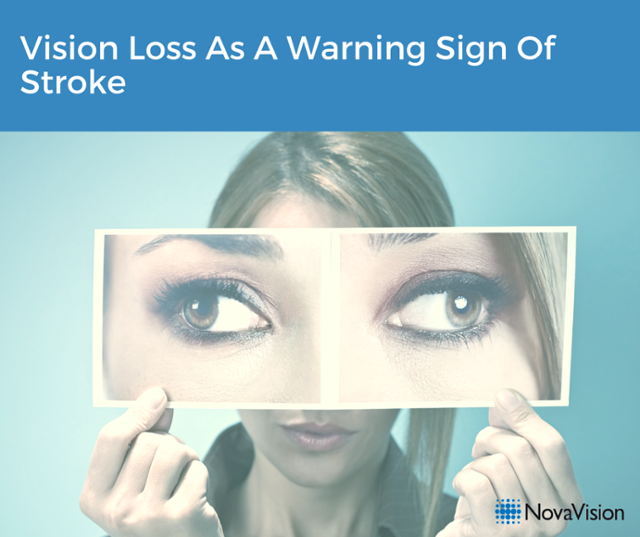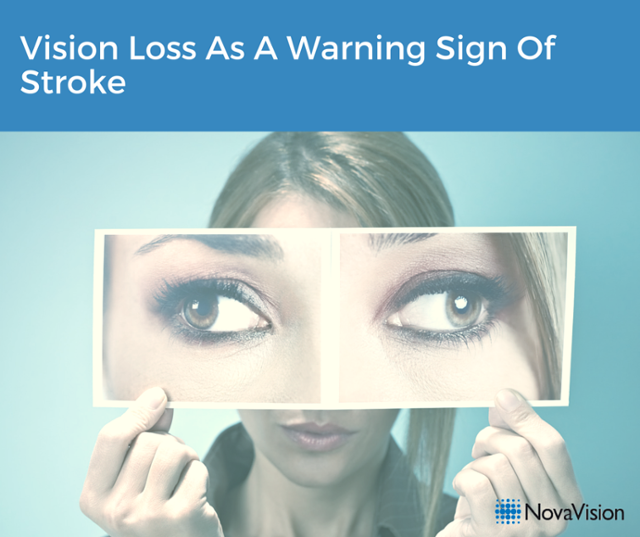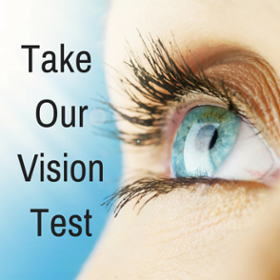
In the past we have spoken about vision loss as a result of stroke and as a result how patients may run into objects, trip or fall, knock things over, lose their place when reading, or be surprised by people or objects that seem to appear suddenly out of nowhere. They may also become afraid of venturing out in public, often because they easily get lost in crowded areas. However, what we didn’t cover is that a sudden but reversible vision loss may also be an indication of an impending stroke.
As A Symptom For Identifying A Possible Onset Of Stroke
Before a person suffers from a stroke, they have often already experienced a TIA, a Transient Ischemic Attack. This is also called a “mini stroke”, because the range of physical symptoms and the underlying causes are the same as in a stroke, the difference is that these are not permanent. Symptoms disappear within a few minutes or hours, and no brain damage will be visible in a CT or MRT.
Vision loss to either the left or right side of the visual field can be symptom of a TIA. More often however, a TIA presents with a type of vision loss not typically for a stroke. Often patients experience vision loss in one eye, first the eye seems to dim as everything is seen through an opal glass pane, then vision is completely lost. As mentioned, the vision loss is reversible, therefore referred to as “Transient Monocular Blindness” or TMB. There have also been reports of the surrounding appearing to be grey, objects looking blurry, and patients becoming aggravated when exposed to bright light. 2
If this or any other symptom associated with a stroke occurs – loss of ability to move in one side of the body, loss of ability to speak, disorientation etc., please seek the immediate attention of a medical professional1. One of the most important things you can do to mitigate the impact of a stroke is to act fast so if you experience any of these symptoms, don’t leave it up to chance.
As A Result Of Stroke
Various types of vision deficits can occur after a stroke or other brain injury, including the inability to recognize objects or faces, color vision deficits and difficulty in perceiving certain types of motion. These conditions occur because of damage caused to specific regions of the visual cortex or its connecting neural network. In some cases the patients are unable to articulate their symptoms as blindness.
According to stroke.org, up to 66% of people who suffer from a stroke experience changes to their vision. Aside from difficulty seeing, these changes can also have negative effects on your overall recovery. Decreased coordination and balance issues are not uncommon. Fortunately, vision problems do sometimes improve however in the vast majority of cases specific rehabilitation is required. Approximately 20% of stroke sufferers will have a permanent visual field deficit. Visual field deficit usually manifests itself as half of one’s visual picture being blanked out this is called hemianopia however there are other common occurrences:
Types Of Vision Loss
Hemianopia
Stroke victims with Hemianopia experience blindness in one half of their line of vision. If you have suffered from a stroke that occurred in the left hemisphere of your brain, your ability to see properly in the right visual field of each eye may be negatively affected. On the other hand, if you have suffered a stroke in the right hemisphere of your brain, the left visual field of each eye may be affected.
Quadrantanopia
This is similar to hemianopia but the loss of vision occurs in a quarter of your visual field, as opposed to half.
Scotoma
This condition refers to spotty vision or smaller area of blindness than hemianopia or quadrantanopia.
Tunnel Vision
This condition is fairly self-explanatory, referring to a loss of peripheral vision that mimics looking through a tunnel. – This is not correct. Bitemporal hemianopia presents as a feeling of having “blinders”, the very periphery to the left and right is gone, but a large part of the central vision is fine because one eye covers for the lost vision of the other eye. Tunnel vision is a result of a bilateral stroke affecting both halves of the visual field, with a macular island of vision. This is often spared because the connected area in the visual cortex has a “back up” blood supply that might still be intact and save this region from damage.
What You Can Do To Recover Your Vision?
Luckily, there are several treatment options available. There are three main strategies for potential visual rehabilitation: restoration, compensation or substitution.
Restoration therapy
Restoration is the only type of therapy that provides actual improvement in the range or sensitivity of the patient’s field of vision. Repetitive stimulation has proven effective in the recovery of other functions such as movements of lower limbs after stroke. Likewise systematic repetitive visual training can also lead to recovery. NovaVision’s VRT is an excellent example of this and is supported by many years of research and clinical data.
Compensatory techniques
Another option is compensation which uses saccadic training, patients are trained to rapidly and continuously scan their surroundings in order to direct their gaze towards the blind field, bringing the previously unseen objects within their sighted field. An example of this would be NeroEyeCoach, and you can learn more about this option here.
Substitution
Substitution refers to the use of optical aids whereby the sighted field can be extended towards the blind field. This is a coping strategy that does not increase sensitivity in the blind field. This approach however is reported to suffer from low patient compliance. Also, many stroke patients find the use of prisms to be visually confusing and reject this coping technique.
Whether you are working on your recovery or experiencing vision loss for the first time, it is always important to be safe and don’t ever hesitate to reach out to a medical professional for help. Not only may they play a vital role in your recovery but they may save your life. Remember to be aware of your senses and always act FAST!
Sources


